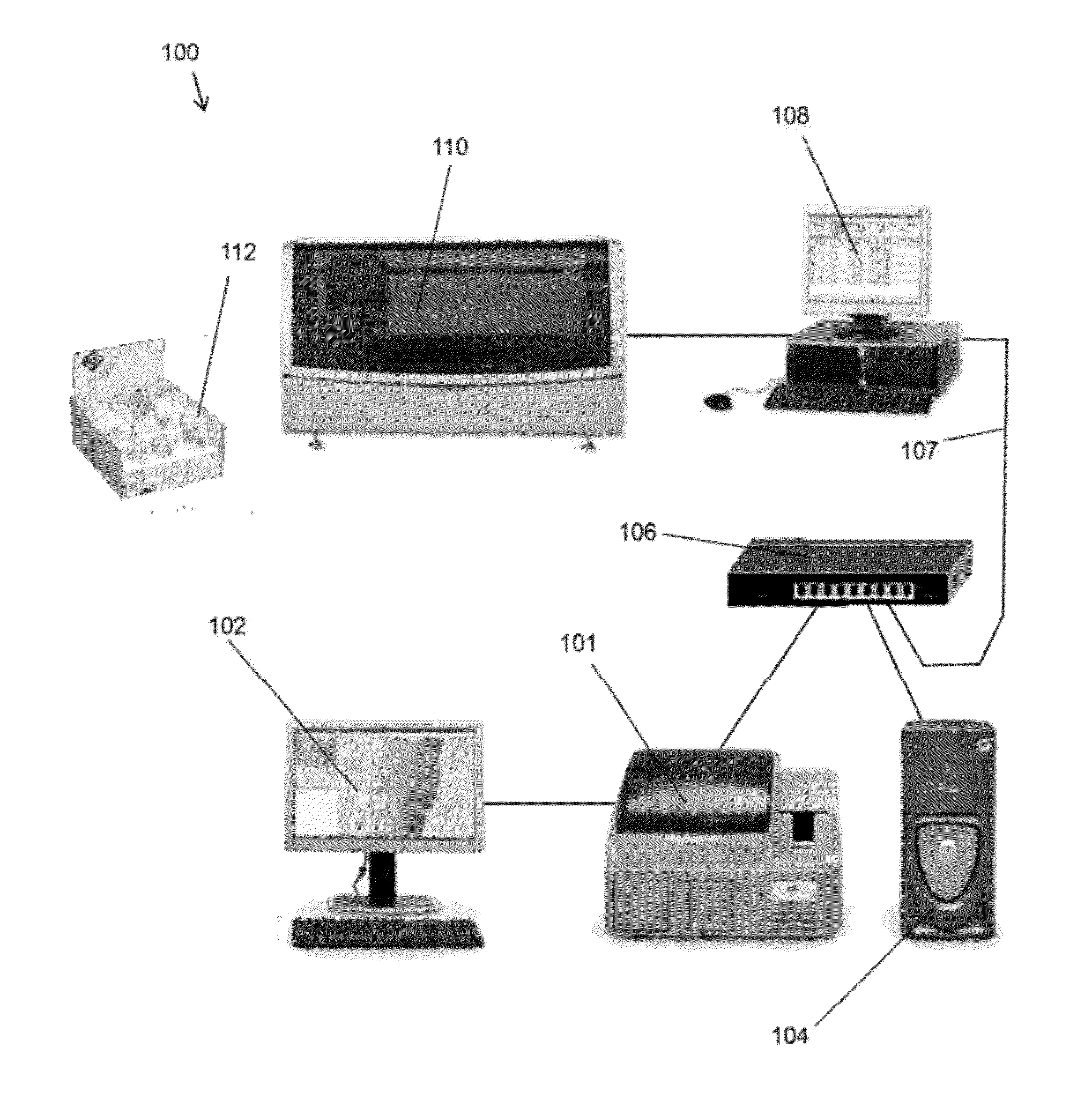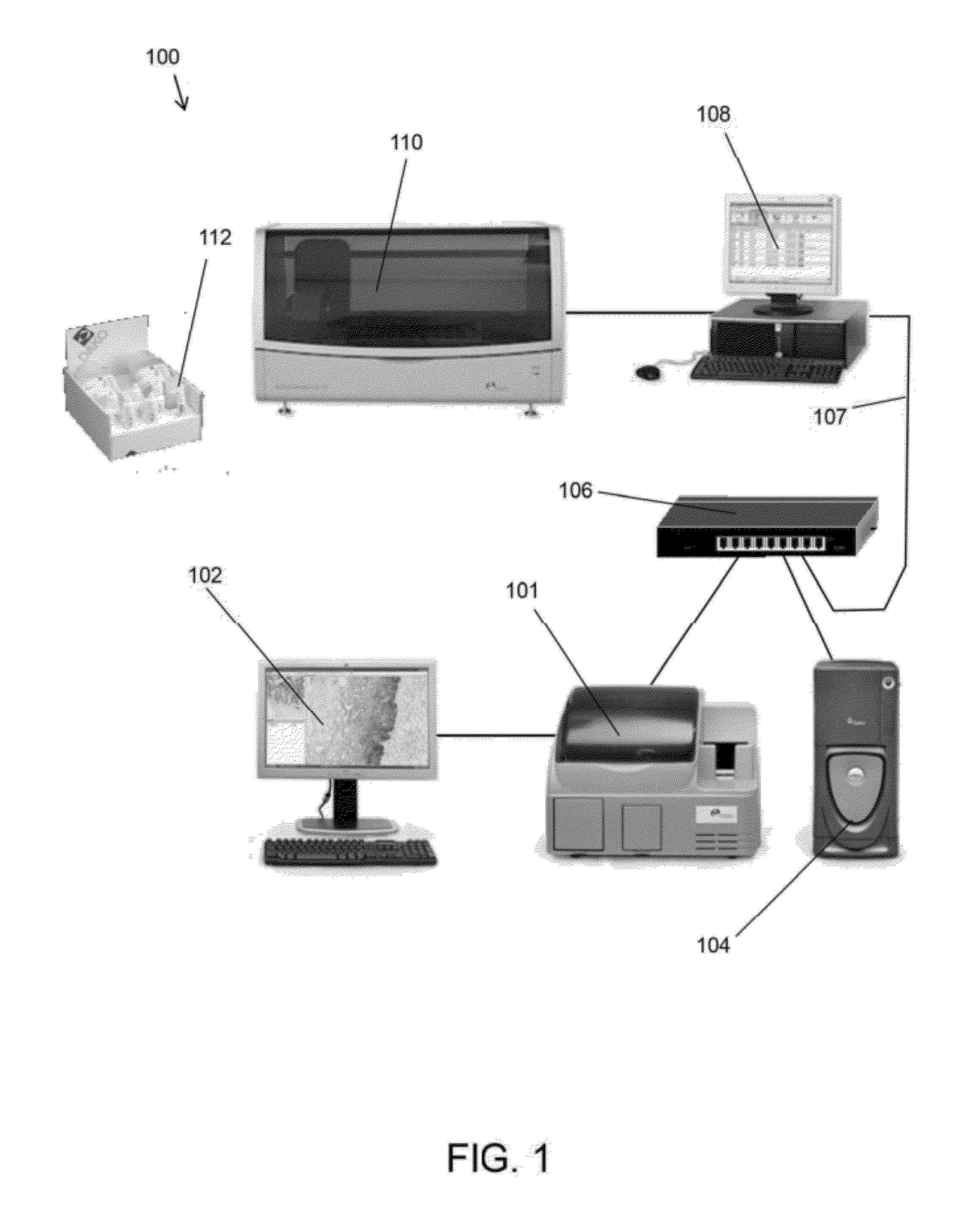Methods and systems for analyzing images of specimens processed by a programmable quantitative assay
a quantitative assay and image processing technology, applied in the field of quantitative staining and imaging of specimens, can solve the problems of high variance of the shape and size of optically discernible objects within and the analysis of histochemical staining has been largely regarded as non-quantitative or semi-quantitative at best, and the average size of the optically discernible objects in the image of the specimen is high, and the variance of the shape and size of the optically discern
- Summary
- Abstract
- Description
- Claims
- Application Information
AI Technical Summary
Problems solved by technology
Method used
Image
Examples
embodiments
Additional Examples and Embodiments
[0253]The term “sample” may mean a representative part or a single item from a larger whole or group, an amount or portion of a matter or object that may contain a target to be detected, e.g. a portion or amount of biological, chemical, environmental material comprising a target molecule, particle, structure to be analyzed, e.g. a biopsy sample, a food sample, a soil sample, etc. A sample may show what the rest of the matter or object is or should be like. A sample may be, for example, a sample from a biological specimen, an environmental sample, e.g. a sample of a soil or a sample of a spillage, a food sample, and a portion of a library of organic molecules.
[0254]A biological sample may be a sample including suspended cells and / or cells debris, e.g. blood sample, suspension of cloned cells, body tissue homogenate, etc; a sample including intact or damaged cells of an animal body, a body tissue, smear or fluid or a sample of a tumor, e.g. a biopsy ...
experimental examples
Example 1
Quantification of a Target in a Histological Sample
[0495]In order to define a number of single entities of a target in a sample and, in particularly, total number of said units, e.g. single target protein molecules, several complex equilibrium experiments may be performed, employing:
[0496]Several Reference samples of a test material with identical, but unknown, levels of an immobilized protein molecules, Pr. (e.g. serial sections of a single block of homogeneous Her2 reference cells lines);
[0497]A primary antibody, Ab1 (e.g. a high affinity monoclonal Rabbit-anti-HER2) with unknown dissociation constant, Kd1 that binds to said protein,
[0498]An Enzyme labeled secondary antibody, Ab2 with unknown dissociation constant, Kd2, that binds to said primary antibody.
[0499]According to the present invention the level of immobilized target in a sample, e.g. a protein, can be expressed as counted single molecule dots (PDQA) per nucleus (e.g. in reference cell lines samples), or per are...
example 2
Quantification of a Target in a Histological Sample (Method II)
[0732]The method (II) for estimation of the total (absolute) number of target molecules in cells has a number of similar approaches compared to the method (I), however it has also some differences.
[0733]In the previously described method equilibrium conditions should be established for both primary antibody and labeled secondary antibody. In case of high target concentrations this may present a difficulty as depletion of binding agents during incubations will occur and it will thus require multiple and prolonged incubations with the binding agents. The present method utilizes that using very high concentration of binding agents a “top” level of binding (which means that essentially all binding sites in the sample will be saturated with the corresponding binding agent) can be established without having the depletion problems. Evidently never 100%, but 90-99% binding of a protein target with a high affinity primary antibod...
PUM
 Login to View More
Login to View More Abstract
Description
Claims
Application Information
 Login to View More
Login to View More - R&D
- Intellectual Property
- Life Sciences
- Materials
- Tech Scout
- Unparalleled Data Quality
- Higher Quality Content
- 60% Fewer Hallucinations
Browse by: Latest US Patents, China's latest patents, Technical Efficacy Thesaurus, Application Domain, Technology Topic, Popular Technical Reports.
© 2025 PatSnap. All rights reserved.Legal|Privacy policy|Modern Slavery Act Transparency Statement|Sitemap|About US| Contact US: help@patsnap.com



